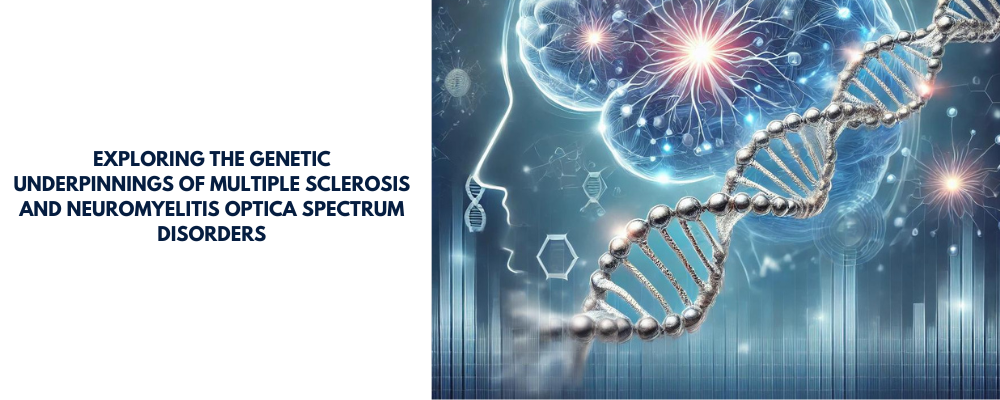Exploring the Genetic Underpinnings of Multiple Sclerosis and Neuromyelitis Optica Spectrum Disorders

Inflammatory demyelinating diseases like Multiple Sclerosis (MS) and Neuromyelitis Optica Spectrum Disorders (NMOSD) are complex conditions that impact the central nervous system (CNS). These diseases lead to damage in the protective myelin sheath surrounding nerve fibers, disrupting nerve signal transmission. While both MS and NMOSD share some similarities, they have distinct clinical and genetic profiles that are essential for understanding their pathogenesis and progression.
Multiple Sclerosis: A Multifactorial Autoimmune Disease
Multiple sclerosis (MS) is an autoimmune disorder characterized by inflammation, demyelination, and neurodegeneration. Affecting approximately 2.5 million people worldwide, MS is more prevalent in young adults and occurs more frequently in women than men. The geographic distribution of MS is notable, with higher incidence rates observed in temperate regions, such as North America and Europe, compared to tropical areas.
Genetics play a significant role in determining an individual's susceptibility to MS, though environmental factors such as vitamin D levels, viral infections (e.g., Epstein-Barr virus), and smoking also contribute. Recent advances in genetic research have shed light on several key genes and loci associated with MS risk, including the human leukocyte antigen (HLA) region on chromosome 6. The HLA-DRB1*15:01 allele, in particular, has been identified as a major genetic risk factor, with carriers being three to four times more likely to develop MS.
Neuromyelitis Optica Spectrum Disorders
NMOSD, often confused with MS due to overlapping symptoms, is now recognized as a distinct condition primarily affecting the optic nerves and spinal cord. Unlike MS, which presents with a wide variety of clinical manifestations, NMOSD typically involves severe optic neuritis and transverse myelitis, often leading to blindness and paralysis.
One of the hallmark features of NMOSD is the presence of aquaporin-4 antibodies (AQP4-IgG) in the majority of patients. These antibodies target the water channel protein aquaporin-4, leading to inflammation and damage to the CNS. Interestingly, a small subset of NMOSD patients test negative for AQP4-IgG but may have antibodies against myelin oligodendrocyte glycoprotein (MOG-IgG).
Implications for MS Diagnosis and Research
The results of this study underscore the potential utility of PRS in supporting MS diagnosis, particularly in distinguishing between individuals with high and low genetic risk. A high PRS could reinforce a diagnosis of MS in patients with ambiguous symptoms, while a low PRS may serve as a red flag to consider alternative diagnoses. This could prevent misdiagnosis of conditions that mimic MS, ensuring more accurate and timely treatment.
However, it is important to note that this study’s findings are specific to individuals of European ancestry, as the PRS was derived from GWAS studies that primarily included European populations. The application of this genetic risk model to other populations may yield different results due to variations in genetic architecture and disease susceptibility across ancestries.
Genetic Contributions to MS and NMOSD
Research into the genetic basis of MS and NMOSD has revealed both shared and distinct genetic risk factors. While HLA genes are implicated in both diseases, NMOSD is also associated with specific genetic variants in the AQP4 and TNXB genes. The AQP4 gene is of particular interest, as it encodes the aquaporin-4 water channel, which is the primary target of autoantibodies in NMOSD.
Studies have shown that certain HLA class II alleles, such as DRB116:02 and DQB105:02, are associated with an increased risk of NMOSD in specific populations, including individuals of Asian and Latin American descent. These findings highlight the role of ethnic and geographic diversity in disease susceptibility, further complicating the genetic landscape of inflammatory demyelinating diseases.
The Role of Environmental Factors
Environmental factors, such as exposure to sunlight and vitamin D levels, are known to influence the risk of developing MS. Vitamin D plays a crucial role in immune regulation, and studies have shown that higher levels of this vitamin are associated with a reduced risk of MS. Conversely, low vitamin D levels have been linked to increased disease activity and progression.
In NMOSD, the role of environmental factors is less clear. However, there is evidence to suggest that viral infections and geographic factors may contribute to disease onset. For instance, NMOSD is more prevalent in non-European populations, suggesting that genetic predisposition combined with environmental triggers may play a significant role in disease development.
Advances in Genetic Research
Recent advances in genome-wide association studies (GWAS) have identified multiple genetic variants associated with MS susceptibility. In addition to HLA-DRB1*15:01, genes involved in immune regulation, such as IL7R and IL2RA, have been implicated in the disease. These genes encode components of the immune system, further supporting the idea that MS is driven by dysregulated immune responses.
In NMOSD, research is still ongoing to identify the genetic factors that contribute to disease susceptibility and progression. While much of the focus has been on the AQP4 gene and its role in the disease, other genes involved in immune function, such as IL-17 and CD58, are also being investigated for their potential role in NMOSD pathogenesis.
Conclusion
MS and NMOSD are complex diseases with both genetic and environmental components. Advances in genetic research are helping to unravel the mysteries of these conditions, paving the way for new treatments and, ultimately, a better quality of life for those affected by these debilitating diseases.
Reference:
Ortiz, G. G., Torres-Mendoza, B. M., Ramírez-Jirano, J., Marquez-Pedroza, J., Hernández-Cruz, J. J., Mireles-Ramirez, M. A., & Torres-Sánchez, E. D. (2023). Genetic basis of inflammatory demyelinating diseases of the central nervous system: multiple sclerosis and neuromyelitis optica spectrum. Genes, 14(7), 1319.
